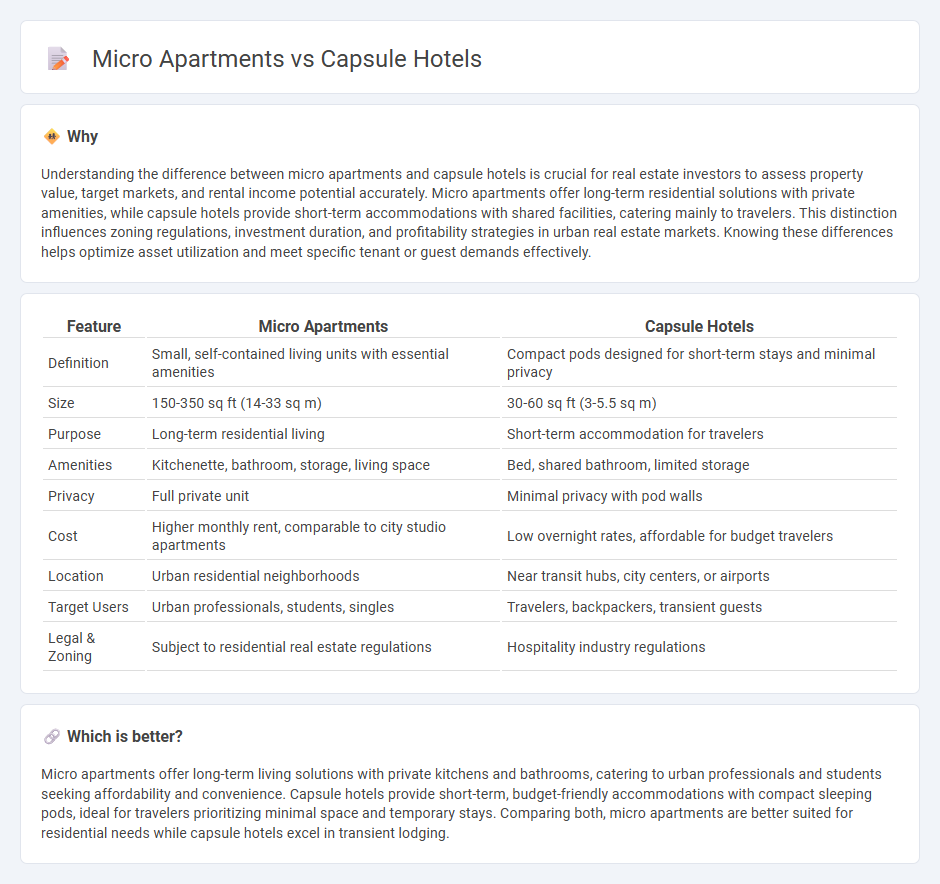
Micro apartments offer compact, self-contained living spaces typically ranging from 200 to 400 square feet, designed to maximize functionality in urban areas. Capsule hotels provide ultra-compact, pod-like accommodations primarily for short-term stays, emphasizing minimalism and cost-efficiency. Explore the key differences between these innovative housing solutions to find out which suits your lifestyle needs.
Why it is important
Understanding the difference between micro apartments and capsule hotels is crucial for real estate investors to assess property value, target markets, and rental income potential accurately. Micro apartments offer long-term residential solutions with private amenities, while capsule hotels provide short-term accommodations with shared facilities, catering mainly to travelers. This distinction influences zoning regulations, investment duration, and profitability strategies in urban real estate markets. Knowing these differences helps optimize asset utilization and meet specific tenant or guest demands effectively.
Comparison Table
| Feature | Micro Apartments | Capsule Hotels |
|---|---|---|
| Definition | Small, self-contained living units with essential amenities | Compact pods designed for short-term stays and minimal privacy |
| Size | 150-350 sq ft (14-33 sq m) | 30-60 sq ft (3-5.5 sq m) |
| Purpose | Long-term residential living | Short-term accommodation for travelers |
| Amenities | Kitchenette, bathroom, storage, living space | Bed, shared bathroom, limited storage |
| Privacy | Full private unit | Minimal privacy with pod walls |
| Cost | Higher monthly rent, comparable to city studio apartments | Low overnight rates, affordable for budget travelers |
| Location | Urban residential neighborhoods | Near transit hubs, city centers, or airports |
| Target Users | Urban professionals, students, singles | Travelers, backpackers, transient guests |
| Legal & Zoning | Subject to residential real estate regulations | Hospitality industry regulations |
Which is better?
Micro apartments offer long-term living solutions with private kitchens and bathrooms, catering to urban professionals and students seeking affordability and convenience. Capsule hotels provide short-term, budget-friendly accommodations with compact sleeping pods, ideal for travelers prioritizing minimal space and temporary stays. Comparing both, micro apartments are better suited for residential needs while capsule hotels excel in transient lodging.
Connection
Micro apartments and capsule hotels both maximize limited urban spaces by offering compact, efficient living units designed for affordability and convenience. Real estate developers leverage modular design and innovative layouts in both models to address housing shortages and high property costs in densely populated cities. These space-saving solutions reflect a growing trend in urban real estate toward minimalistic, flexible living environments that cater to transient populations and young professionals.
Key Terms
Space Efficiency
Capsule hotels maximize space efficiency by offering compact, individual sleeping pods equipped with essential amenities, ideal for short stays in urban environments. Micro apartments provide multifunctional living areas within a slightly larger footprint, combining kitchenettes, bathrooms, and living spaces for long-term residents seeking minimalistic lifestyles. Explore the benefits and design innovations behind these space-saving accommodations to determine which solution suits your needs best.
Zoning Regulations
Zoning regulations play a critical role in the development and operation of capsule hotels and micro apartments, dictating land use, building height, density, and occupancy limits. Capsule hotels often face strict zoning restrictions related to commercial hospitality use, while micro apartments must comply with residential zoning codes and minimum unit size standards. Explore detailed zoning guidelines and compare their impacts on these innovative housing solutions for a comprehensive understanding.
Occupancy Type
Capsule hotels primarily target transient guests seeking short-term stays with compact, private sleeping pods designed for efficiency and affordability. Micro apartments cater to long-term residents requiring functional living spaces with essential amenities that maximize limited square footage while supporting daily life activities. Explore the nuances of occupancy types and design strategies that differentiate these two urban housing solutions.
Source and External Links
THE 10 BEST Tokyo Capsule (Pod) Hotels 2025 - Lists top capsule hotels in Tokyo, including The Millennials Shibuya and Do-c Shibuya Ebisu.
Best Capsule Hotels Around the World - Highlights unique capsule hotels globally, with a focus on Japan's Nine Hours and First Cabin brands.
A Guide to Capsule Hotels in Japan - Provides an overview of capsule hotels in Japan, including their unique features and accommodations for different genders.
 dowidth.com
dowidth.com